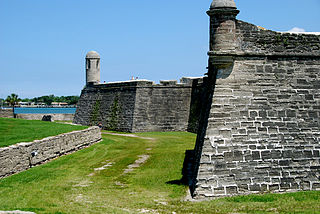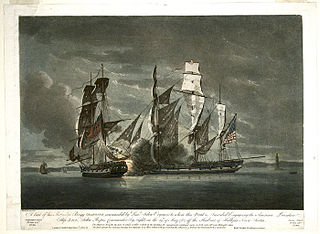Related Research Articles

Patrick Tonyn (1725–1804) was a British General who served as the last British governor of East Florida, from 1774 to 1783. His governorship lasted the span of the American Revolution. East Florida was a Loyalist colony during the war.
The Battle of Alligator Bridge took place on June 30, 1778, and was the only major engagement in an unsuccessful campaign to conquer British East Florida during the American Revolutionary War. A detachment of Georgia militiamen under the command of General James Screven chased Thomas Brown's Loyalist company into a large position of British regulars established by British Major Mark Prevost and were turned back.

The Battle of Wyoming, also known as the Wyoming Massacre, was a military engagement during the American Revolutionary War between Patriot militia and a force of Loyalist soldiers and Iroquois warriors. The battle took place in the Wyoming Valley of Pennsylvania on July 3, 1778, in what is now Luzerne County. The result was an overwhelming defeat for the Americans. The battle is often referred to as the "Wyoming Massacre" because of the roughly 300 Patriot casualties, many of whom were killed by the Iroquois as they fled the battlefield or after they had been taken prisoner.

The siege of Savannah or the second battle of Savannah was an encounter of the American Revolutionary War (1775–1783) in 1779. The year before, the city of Savannah, Georgia, had been captured by a British expeditionary corps under Lieutenant-Colonel Archibald Campbell. The siege itself consisted of a joint Franco-American attempt to retake Savannah, from September 16 to October 18, 1779. On October 9 a major assault against the British siege works failed. During the attack, Polish nobleman Count Casimir Pulaski, leading the combined cavalry forces on the American side, was mortally wounded. With the failure of the joint attack, the siege was abandoned, and the British remained in control of Savannah until July 1782, near the end of the war.

The western theater of the American Revolutionary War (1775–1783) was the area of conflict west of the Appalachian Mountains, the region which became the Northwest Territory of the United States as well as what would become the states of Arkansas, Kentucky, Louisiana, Missouri, and Tennessee. The western war was fought between American Indians with their British allies in Detroit, and American settlers south and east of the Ohio River, and also the Spanish as allies of the latter.

Samuel Elbert was an American merchant, soldier, slave owner, and politician from Savannah, Georgia.

The siege of Pensacola, fought from March 9 to May 10, 1781, was the culmination of Spain's conquest of West Florida during the Gulf Coast Campaign of the American Revolutionary War.
The Battle of Thomas Creek, also known as the Thomas Creek Massacre, was an ambush of a small detachment of mounted Georgia Militia by a mixed force of British soldiers, Loyalist militia, and British-allied Indians on May 17, 1777 near the mouth of Thomas Creek in northern East Florida. The encounter was the only major engagement in the second of three failed attempts by American forces to invade East Florida in the early years of the American Revolutionary War.
Sawpit Bluff was a small settlement in East Florida during the American Revolutionary War on the site of a plantation at the mouth of Sawpit Creek where it discharges into Nassau Sound opposite the south end of Amelia Island. It was the location of a proposed rendezvous between mounted militia from Sunbury, Georgia and Continental troops under the command of Lt. Col. Samuel Elbert during the second invasion of Florida in May 1777.
Lieutenant-Colonel Thomas Brown was a British planter and military officer. Intending to become a quiet colonial landowner, instead he lived a turbulent and combative career. During the American War of Independence, he was a prominent Loyalist in the Province of Georgia and served as an officer in the King's Carolina Rangers. Following the American victory in the war, Brown was exiled first to East Florida, and later to Saint Vincent in the Caribbean.

The siege of St. Augustine was a military engagement that took place during June–July 1740. It involved a British attack on the city of St. Augustine in Spanish Florida and was a part of the much larger conflict known as the War of Jenkins' Ear.
The siege of Augusta took place between May 22, 1781, and June 6, 1781. American Patriot forces, led by Brigadier General Andrew Pickens and Lieutenant Colonel Henry "Light Horse Harry" Lee, were successful in capturing Augusta, Georgia held by British loyalist militia. Fort Cornwallis, the primary British defence, was successfully exposed to cannon fire by the construction of a tower 30 feet (9.1 m) high on which the Americans mounted a small cannon. The British surrendered on June 6.
The Province of Georgia in the American Revolution was a significant battleground in the war for independence. Initially, Georgia's population was divided on how to respond to revolutionary activities and heightened tensions in other colonies. As the only colony not represented at the First Continental Congress in 1774, Georgia remained hesitant to join the revolutionary cause, owing to its prosperity under British rule and reliance on British protection against Native American attacks. However, after the outbreak of hostilities in 1775, radical Patriots gained control of the provincial government, driving many Loyalists out and eventually joining the Second Continental Congress.
Two vessels of the Royal Navy have borne the name HMS Germaine or Germain, in honour of Lord Germain:

Fort San Carlos was a military structure built in 1816 to defend the Spanish colonial town of Fernandina, Florida, now called Old Town, which occupied a peninsula on the northern end of Amelia Island. The fort, a lunette fortification, stood on the southwest side of the town next to the harbor, on a bluff overlooking the Amelia River. It was made of wood and earthworks, backed with a wooden palisade on the east side, and armed with an eight or ten gun battery. Two blockhouses protected access by land on the south, while the village was surrounded with military pickets. An 1821 map of Fernandina shows that the street plan, laid out in 1811 in a grid pattern by the newly appointed Surveyor General of Spanish East Florida, George J. F. Clarke, today preserves nearly the same layout as that of 1821. The fort occupied the area bounded by the streets Calle de Estrada, Calle de White, and Calle de Someruelos. The structure itself has disappeared and only traces remain in what is now Fernandina Plaza Historic State Park.

Fort Morris is an earthen works fort in Liberty County, Georgia, in the United States. The fort is on a bend in the Medway River and played an important role in the protection of southeast Georgia throughout various conflicts beginning in 1741 and ending in 1865 at the conclusion of the American Civil War, including the French and Indian and American Revolutionary Wars and War of 1812. The historic site is 70 acres (28 ha) in size and sits at an elevation of 23 feet (7.0 m).
William Panton was the head of a group of five Scottish merchants who in 1783 founded the powerful and influential trading firm of Panton, Leslie & Company at St. Augustine, then the capital of British East Florida. They formed a partnership to trade with the Indians of Florida and the Spanish borderlands on the southern frontier of the British colonies. By 1795 the company had established a monopoly on trade with the Indian tribes of what is now the southeastern United States, sanctioned by successive governors of Spanish Florida.

The Province of Nova Scotia was heavily involved in the American Revolutionary War (1775–1783). At that time, Nova Scotia also included present-day New Brunswick until that colony was created in 1784. The Revolution had a significant impact on shaping Nova Scotia, "almost the 14th American Colony". At the beginning, there was ambivalence in Nova Scotia over whether the colony should join the Americans in the war against Britain. Largely as a result of American privateer raids on Nova Scotia villages, as the war continued, the population of Nova Scotia solidified their support for the British. Thousands of Loyalist refugees fled to Nova Scotia during the war, and many were resettled in the region after the signing of the 1783 Treaty of Paris as "United Empire Loyalists".
Daniel McGirt, also given as McGirtt or McGirth,, a native of the Camden District in South Carolina, was the leader of an outlaw gang that operated in northern Florida and southern Georgia during the latter 1700s. Mostly uneducated, he made a living as a hunter and trapper until the American Revolutionary War broke out, whereupon he served for a while as a scout for the Continental Army, then switched sides, and became one of the more picturesque minor figures of the war.
The King's Carolina Rangers (KCR) was a loyalist militia regiment active during the American War of Independence. The KCR was composed of nine infantry companies, of which one was converted into a troop of dragoons in 1782. The unit primarily saw action in the South Carolina and Georgia theatres of the conflict.
References
- Bullen, Ripley P (April 1951). "Fort Tonyn and the Campaign of 1778". The Florida Historical Quarterly. 29 (4). Florida Historical Society: 253–260. JSTOR 30139708.